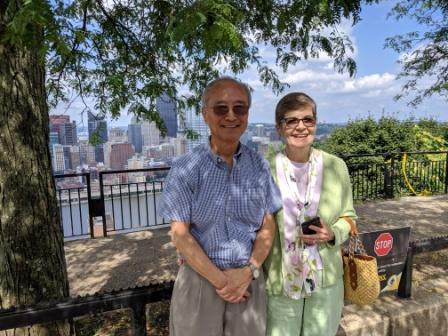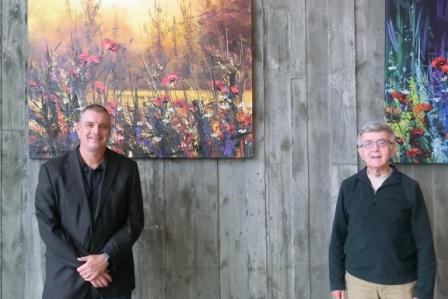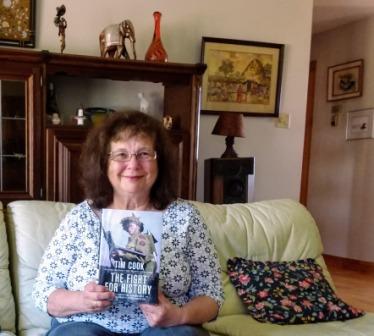
Retired engineer Charlie (Chi-Yong) Choi with his wife Susan. (Photo credit: Brien Robertson)
September 30, 2021. Over the past years, Pieter has been researching the stories of Canadian soldiers. It’s an honour to learn of their service and the hardships and sacrifices they endured. But, as we know from current news events, war also impacts civilians.
Until we met our good friend Charlie (Chi-Yong) Choi, a retired engineer, most of what I knew about the Korean War came from watching M*A*S*H (see https://en.wikipedia.org/wiki/M*A*S*H_(TV_series)), and even then I must admit I wasn’t sure when or why the war took place. But when Charlie, who was born in Korea, talked about how he and his family were impacted by the war, it was an eye-opener.
I was surprised to learn that more than 26,000 Canadians served on land, at sea, and in the air during this conflict as part of the United Nations Allied Forces. 516 died during the war. (See https://www.veterans.gc.ca/eng/remembrance/wars-and-conflicts/korean-war)
After reading about the recent Korean War Veterans Luncheon on Korean Thanksgiving, Charlie agreed to share his childhood memories of that traumatic period. His wife Susan wrote that “…A few tears were shed by both of us as he put his memories on paper….” Once you read what he and his family endured, you’ll understand why. (See https://bordencarletonresearchproject.wordpress.com/2021/09/24/pei-korean-war-veterans-luncheon-hosted-by-the-embassy-of-the-republic-of-korea/)
Charlie set the scene with some background information. “…The war erupted on 6/25/1950 and ended with a cease fire under the ‘Korean Armistice Agreement’ on 7/27/1953. This agreement created the ‘DMZ’ – a border dividing South and North Korea….” DMZ refers to Demilitarized Zone.
Before the war began in 1950, 4 year old Charlie “…lived in a two story western style house with my parents, my 2 years and 6 month old brother, my 6 1/2 month old sister and a house maid. We lived in the northern part of Seoul City just east of the capitol and the Presidential Palace known as the Blue House. I remember being very happy and enjoyed daily tricycle rides with my younger brother in our neighborhood with my mother strolling behind us. It was a very peaceful and comfortable life….”
… Life as we knew it changed on June 25, 1950….
Then everything changed. “…We woke up early on the morning of 6/25/1950 to earthquake-like vibrations and loud ground thumping noises. We realized that the North Korean Army was coming down. They were just north of the mountains behind our house. There were explosions from tank artillery and bombardment that became louder and louder as they got closer….”
That was scary enough, but then the situation worsened. “…A few hours later, we heard a banging at the front gate of our house, yelling for us to open the gate. About 10 uniformed North Korean soldiers with machine guns rushed into the house, looking for my father, who worked for the government. Fortunately, my father had fled the house, to an unknown location, hours earlier. The soldiers searched the house and the yard for several hours before retreating…”
The family caught a lucky break, but then it was decision time. Flee or stay? Charlie’s mother was responsible for 3 pre-schoolers and a maid. “…My mother decided to stay in our house in Seoul, hoping that the North Koreans would be pushed back soon. About a month went by, but the situation got worse. The North Korean Army was infiltrating more and more into the south. Roads and bridges were being destroyed by bombs. Grocery stores and vendors were disappearing, etc. It was getting harder and harder to buy groceries…”
….The agonizing decision was made to flee south…
Charlie’s mother decided it was time to flee. “…Our destination was my paternal grandfather’s farm, where he had moved after retiring. My grandparents had lived in Seoul until around 1939 when they moved to the farm. The farm was south of Onyang, a hot springs resort region which was about 50 miles south of our house in Seoul….”

The long and dangerous journey from Seoul to Onyang. (Map source: http://www.mapquest.com)
Now refugees, the Chois began the journey to his grandfather’s farm in late July 1950. “…We did not know how we would get to my grandfather’s, but just followed my mother’s lead. Mother packed a few small bags for us to carry and the five of us (mother, brother, baby sister, maid and me) started our journey on foot….”
They soon encountered their first obstacle. “…When we arrived at the Han River bridge at the southern tip of Seoul City, the bridge had been destroyed by a bomb in order to stop the North Korean Army’s advance into the south. Crossing the river was a must to get to the farm. This was the first of many difficult hurdles we would have to overcome…”

In Part 2, Charlie’s story continues as his mother searches for a way to cross the Han River…..
Thank you to Charlie Choi for his courage in relating his childhood experience in wartime Korea. Do you have information to share about Canadian soldiers, please email us at memorialtrail@gmail.com, comment on the blog, or send a tweet to @researchmemori1.
© Daria Valkenburg
…..Want to follow our research?….
If you are reading this posting, but aren’t following the blog, you are welcome to do so. Our blog address: https://onthewarmemorialtrail.com/
 4 countries, 6 weeks, 7,000 km – an unforgettable war memorial journey in Europe…. Daria’s book ‘No Soldier Buried Overseas Should Ever Be Forgotten‘ is available in print and e-book formats. Net proceeds of book sales help support research costs and the cost of maintaining this blog. For more information see https://nosoldierforgotten.com/
4 countries, 6 weeks, 7,000 km – an unforgettable war memorial journey in Europe…. Daria’s book ‘No Soldier Buried Overseas Should Ever Be Forgotten‘ is available in print and e-book formats. Net proceeds of book sales help support research costs and the cost of maintaining this blog. For more information see https://nosoldierforgotten.com/

You are also invited to subscribe to our YouTube Channel: On The War Memorial Trail With Pieter Valkenburg: https://www.youtube.com/channel/UCJ591TyjSheOR-Cb_Gs_5Kw.
Never miss a posting! Subscribe below to have each new story from the war memorial trail delivered to your inbox.



















